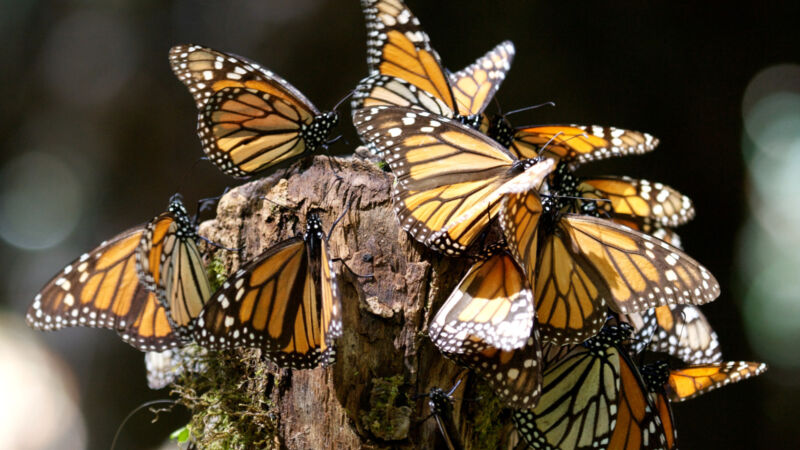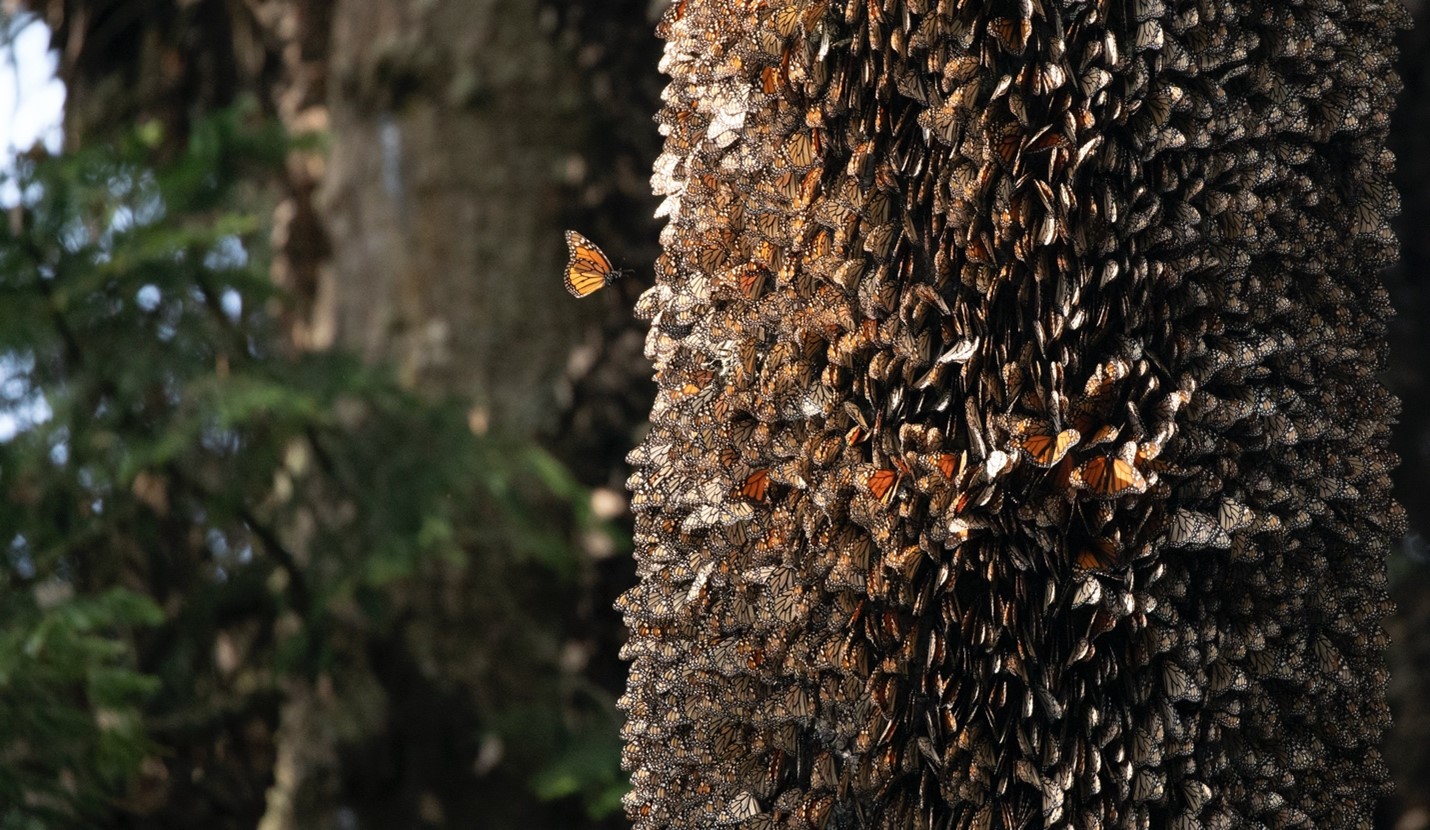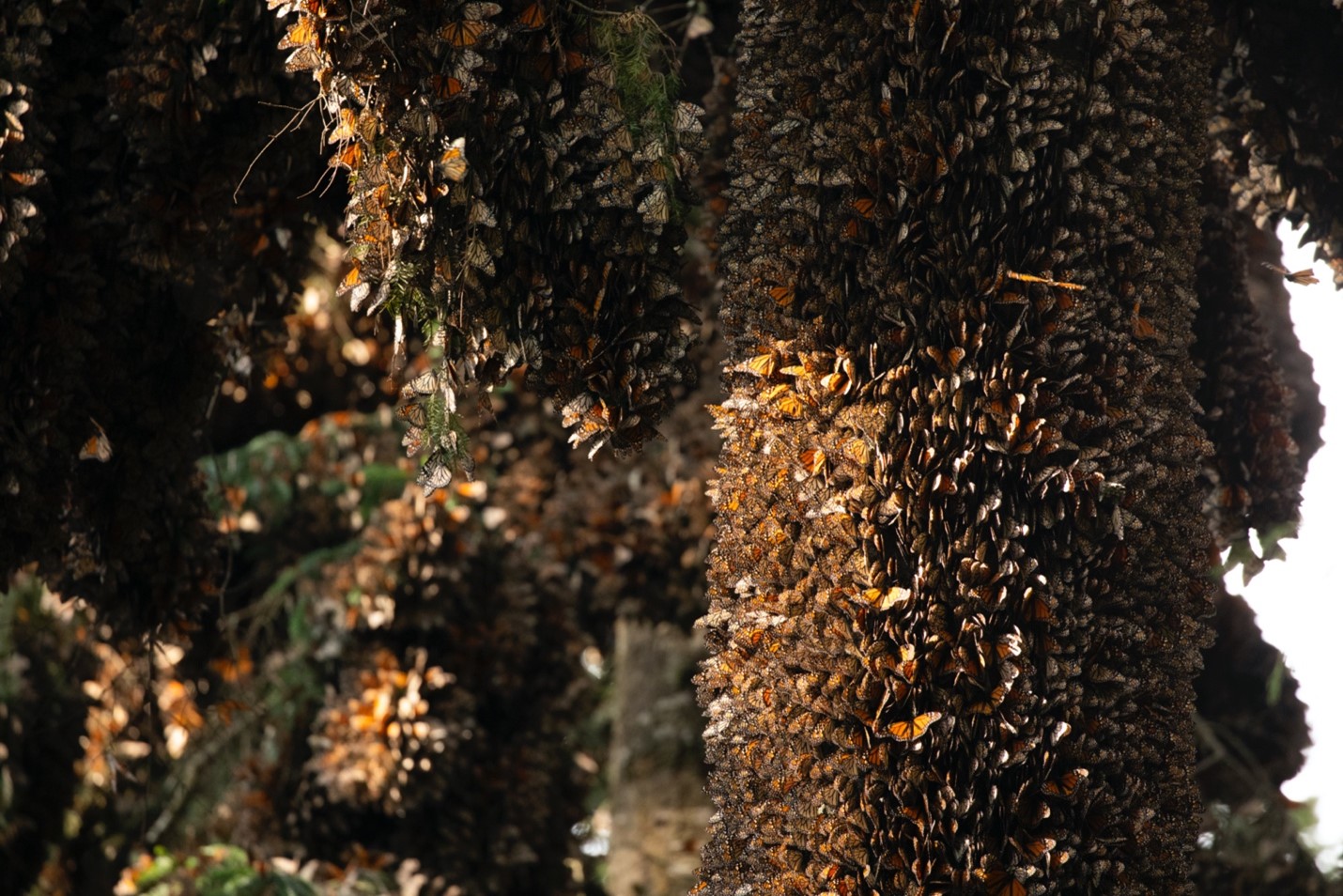
Article and photos contributed by MJV board member and conservation travel guide Court Whelan.

When you encounter your first monarch butterflies in the overwintering groves of Mexico, they seem incredibly fragile and almost helpless. These tiny animals, weighing a fraction of an ounce, have paper-thin wings that look like they could crack and tear with even the slightest touch or bump against a tree.
However, from 20 years of guiding nature expeditions to these magical butterfly forests and seeing the resiliency and strength of these butterflies time and time again, I think they may be among the hardiest of animals alive on our planet today.
As with each year, I have recently returned from a season of guiding ecotourists down to visit the monarch overwintering colonies in the Monarch Biosphere Reserves. And also, as with each year, I return more inspired and more passionate than ever for the collective quest we’re on to save the monarch butterfly and its extraordinary migration.
The reason that I am more inspired and more hopeful than ever? Because it’s working. All of it — it’s working. The many efforts taken by many people to keep the monarchs migrating are showing signs of success. From drastically reducing logging in the monarch forests to a booming ecotourism industry that has added value to the monarchs and their Mexican habitat, extraordinary efforts are happening in Mexico. And in the U.S. and Canada, we’re seeing greater awareness around the monarch and its plight due to films, documentaries, and books, to the many individual efforts of monarch gardens and milkweed planting, so many people are doing amazing work in many areas.

Each year, we’re learning more about what really makes monarchs tick. What genetic programming is responsible for which part of their migration, cognition and decision making. We’re learning more about what habitats are most critical for each stage of their spring, summer, and fall life cycles. And we’re learning the wondrous passion that people all around the world, especially in Mexico, have for these emblematic little butterflies.

Tourism itself is helping save these butterflies
Each year a few hundred thousand travelers embark on their own journey to the Monarch Biosphere Reserves. Among the many inspirational things I see each year, I am continually inspired by the fact that the majority of visitors are local Mexicans, making the trek from Guadalajara, Mexico City, Valle de Bravo, Toluca, and places much farther away simply to gaze upon this local treasure.
What this says to me, as a conservation biologist and conservation travel guide, is that there is a growing and powerful following for the monarchs among those who control much of the fate of these overwintering forests. These local travelers have significant control over their own lands and as hundreds of thousands experience the phenomenon each year, their influence grows. This influence shapes politics and local land policies and it directly and indirectly helps to protect the forest.
And as local communities continue to earn better incomes from tourism and start new businesses like hotels, restaurants and local transpiration services, the butterflies themselves are responsible for the livelihoods of tens of thousands of people. They have become some of the biggest stakeholders and most adamant protectors of the forest.

For the 5% of visitors that are not Mexican citizens, the impact of their visit is disproportionately significant. Awareness and advocacy literally spread across oceans, different time zones, and most importantly northward where much of the monarch migration lifecycle takes place — to Canada and the U.S.
Time and time again I’ll return home and get a message from one of my guests that they have planted a milkweed garden, or they have signed up to volunteer with local monarch organizations, or will be writing their legislators about the need to conserve monarch habitat.
I’ll hear from others saying they plan to contribute financially to a monarch conservation organization, or plan to write an article for a local newspaper or a blog on their own travel or science website about their experience.
These may seem like simple steps, but in aggregate they help create and perpetuate major conservation movements, not just for the monarch, but for all the other critters that depend on similar habitats — pollinators in general being a major one.

A glimpse at the 2021/2022 overwintering season
Much of my inspiration comes from knowing all the great ways that people are helping to save the monarch butterfly.
However, the magnitude of my inspiration is often correlated with the splendor of what we saw together as a group of travelers. That is, in those years when the monarchs are really “putting on a show” for us, I of course get more excited. I’m more excited at just the sheer spectacle, but also knowing that the more impactful and the more moving the experience is, the more people are going to be inspired themselves to continue their journey of monarch amazement and monarch conservation after they return home.
And fortunately, this was indeed one of those years.

We were treated to spectacular scenes from the start to the end of our journey. Tree trunks were covered with monarchs such that you could barely even see the bark.

And cluster upon cluster were found hanging high in the canopy where old-growth oyamel fir trees thrive — a key to their project from wind and adverse weather.

And at mid-day, thousands of monarchs could be seen soaring through the air as they sought out small puddles of water, or simply relocated to a shadier part of the colony.

When we look at the ups and downs the monarchs have had over the last few decades, it can be quite dizzying. If you look at their population counts, it’s like a roller coaster. However, as with most things, understanding the nuances and observing the colonies in real time each and every year gives you a perspective of incredible resilience.
When you’re looking at 10 million butterflies, which become 30 million butterflies the next year, you realize that these tiny insects have an amazing ability to not just inspire and provoke their own protection and conservation from we humans, but they themselves have an astounding ability to recover and rebound as organisms simply by doing what they do.
So next time when you observe a tiny, seemingly fragile monarch, just remember what stunning royalty you’re really in front of.
Cheers to the monarch!
Court
Inspired to discover more ways to support monarch conservation? Here's how to get involved.
The content in this article reflects the views of the author and does not necessarily reflect the positions of the Monarch Joint Venture or its partners.
